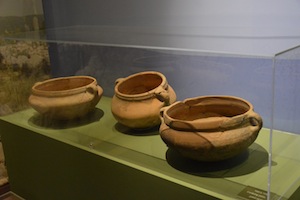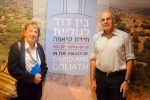The author, Sybil Kaplan and Prof. Yosef Garfinkel at the opening of the exhibit In the Valley of David and Goliath, now at Bible Lands Museum in Jerusalem. (photo by Barry A. Kaplan)
“As the Philistine moved closer to attack him, David ran quickly toward the battle line to meet him. Reaching into his bag and taking out a stone, he slung it and struck the Philistine on the forehead; the stone sank into his forehead, and he fell face down on the ground. So, David triumphed over the Philistine with a sling and a stone; without a sword in his hand, he struck down the Philistine and killed him.” (1 Samuel 17:48-50)
Most of us have read or heard the story of David and Goliath, and some of us have even visited where the battle took place. But now we all have the chance to learn more. On Sept. 5, In the Valley of David and Goliath opened at Bible Lands Museum in Jerusalem. Presented to the public for the first time, the exhibit will be on display until September 2017.
Khirbet Qeiyafa (Fortress of Elah), 20 miles southwest of Jerusalem, on top of a hill overlooking the Valley Elah, was excavated by Prof. Yosef Garfinkel from 2007 to 2012. Garfinkel is the Yigael Yadin Chair in Archeology of Israel at Hebrew University and director of excavations at Khirbet Qeiyafa.
This fortified city was across from Gath, the Philistine city where Goliath lived when he came out to face the Israelites. The evidence indicates that the city was a military outpost for the House of David. In David’s day, the Valley of Elah served as a neutral zone between the Israelites and the Philistines. Excavators discovered a large cache of weapons in Qeiyafa, which Garfinkel identifies as “an area of conflict between two political units.”

Based on carbon-14 dating performed on 28 olive pits, archeologists believe the city lasted from 1020 to 980 BCE. Items found at the site strengthen the connection to King David and religious practices described in the Bible. As well, according to Garfinkel, this Iron Age town was described in the Bible as the location of the battle between David and Goliath 3,000 years ago.
In an interview with Erin Zimmerman for CBS News in 2013, Garfinkel maintained that Khirbet Qeiyafa was a Jewish city for four reasons.
“It has a big casement city wall and houses abutting the city wall,” he said. “This is known from four other sites, so now we have five sites. All these five cities are in Judah, none of them is in Philistia. This is really typical Judean urban planning.”
Second, the bones found in the city all come from kosher animals.
“We have sheep, goat, cattle, but we have no pigs and no dogs,” he said. “On the Philistine side, they consume pigs and also dogs. Up to 20% of the animal bones at Philistine sites are pigs, but here, nothing.”
And, according to Garfinkel, a found pottery shard, also known as an ostracon, is the earliest example of Hebrew writing ever unearthed. On it are written commandments to worship the Lord and to help widows, orphans and slaves.
“It started with the word ‘al ta’as,’ which means ‘don’t do,’ and ‘ta’as,’ ‘to do,’ is only in Hebrew. It’s not Canaanite and not Philistine,” he explained.
Finally, Garfinkel said the absence of idols – which would have been in abundance in other places – points to a Jewish city.
“If you go to Canaanite temples of the Late Bronze [Age], you will find a lot of human and animal figures, but not in Khirbet Qeiyafa. So, the people here really obeyed the biblical taboo on graven images,” he said.
Garfinkel pointed out that, “in the absence of idols, there were religious shrines, and the models predate Solomon’s Temple by about 40 years, yet they match the Bible’s description of the Temple, down to the triple-framed doors. They’re the first physical evidence of Jewish worship in the time of King David.”
Part of the exhibit at the Bible Lands Museum are the two inscriptions that were found – one on a jar and one inscribed with ink on a pottery shard – which contain the distinctly identifiable Hebrew words for “king,” “don’t do” and “judge.”
Among the other objects on display are storage jars, water basins, a model of a house, hundreds of pottery vessels, jar handles with finger impressions, cooking pots and jugs, and the bowl that contained the olive pits.
Most amazing is a stone model shrine, which reflects a Mesopotamian architectural-style before the era of King David, but which probably inspired the look of the palace built by Solomon, David’s son. Features of the model are mentioned in biblical references to King Solomon’s Temple, built decades later.
For Hebrew-speakers traveling to Israel in the near future, exhibit curators will be giving behind-the-scenes tours in Hebrew on Oct. 7, Nov. 11 and Dec. 16.
Sybil Kaplan is a journalist, foreign correspondent, lecturer, food writer and book reviewer who lives in Jerusalem. She also does the restaurant features for janglo.net and leads walks in English in Jerusalem’s market.

